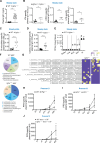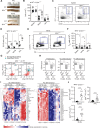Gut IgA functionally interacts with systemic IgG to enhance antipneumococcal vaccine responses
- PMID: 39937896
- PMCID: PMC11817949
- DOI: 10.1126/sciadv.ado9455
Gut IgA functionally interacts with systemic IgG to enhance antipneumococcal vaccine responses
Abstract
The gut microbiota enhances systemic immunoglobulin G (IgG) responses to vaccines, but it is unknown whether this effect involves IgA, which coats intestinal microbes. That IgA may amplify postimmune IgG production is suggested by the impaired IgG response to pneumococcal vaccines in some IgA-deficient patients. Here, we found that antipneumococcal but not total IgG production was impaired in mice with IgA deficiency. The positive effect of gut IgA on antipneumococcal IgG responses started very early in life and could implicate gut bacteria, as these responses were attenuated in germ-free mice recolonized with gut microbes from IgA-deficient donors. IgA could exert this effect by constraining the systemic translocation of gut antigens, which was associated with chronic immune activation, including T cell overexpression of programmed cell death protein 1 (PD-1). This inhibitory receptor may attenuate antipneumococcal IgG production by causing B cell hyporesponsiveness, which improved upon anti-PD-1 treatment. Thus, gut IgA functionally interacts with systemic IgG to enhance antipneumococcal vaccine responses.
Figures





References
-
- Bunker J. J., Flynn T. M., Koval J. C., Shaw D. G., Meisel M., McDonald B. D., Ishizuka I. E., Dent A. L., Wilson P. C., Jabri B., Antonopoulos D. A., Bendelac A., Innate and adaptive humoral responses coat distinct commensal bacteria with immunoglobulin A. Immunity 43, 541–553 (2015). - PMC - PubMed
-
- Grasset E. K., Chorny A., Casas-Recasens S., Gutzeit C., Bongers G., Thomsen I., Chen L., He Z., Matthews D. B., Oropallo M. A., Veeramreddy P., Uzzan M., Mortha A., Carrillo J., Reis B. S., Ramanujam M., Sintes J., Magri G., Maglione P. J., Cunningham-Rundles C., Bram R. J., Faith J., Mehandru S., Pabst O., Cerutti A., Gut T cell-independent IgA responses to commensal bacteria require engagement of the TACI receptor on B cells. Sci. Immunol. 5, eaat7117 (2020). - PMC - PubMed
MeSH terms
Substances
Grants and funding
LinkOut - more resources
Full Text Sources
Research Materials
Miscellaneous

